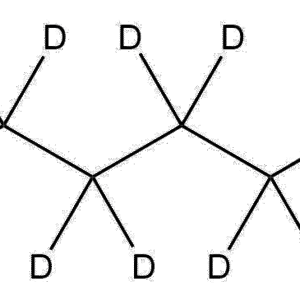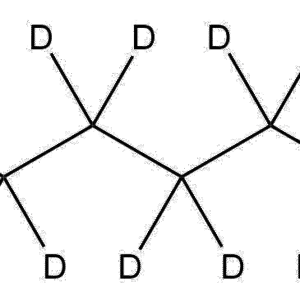OVERVIEW
TRIS-d₁₁, also known as Tris(hydroxymethyl-d₃)amino-d₂-methane, is a fully deuterated form of the widely used biological buffer TRIS (Tris(hydroxymethyl)aminomethane). In this isotopically labeled compound, all hydrogen atoms are replaced with deuterium (a total of 11 deuterium atoms), resulting in a stable, non-radioactive isotopologue ideal for advanced analytical and biochemical studies.
TRIS-d₁₁ retains the buffering characteristics of native TRIS—such as excellent pH stability in the physiological range—while providing isotopic differentiation valuable for NMR, mass spectrometry, and isotopic labeling research. Its deuterated form minimizes proton background signals, offering exceptional clarity in spectroscopic and kinetic isotope effect studies.
CHEMICAL INFORMATION
-
Name: TRIS-d₁₁; Tris(hydroxymethyl-d₃)amino-d₂-methane
-
Molecular Formula: C₄D₁₁NO₃
-
Molecular Weight: 132.20 g/mol
-
CAS Number: 202656-13-1
-
Isotopic Enrichment: ≥ 98 atom % D
-
Chemical Class: Deuterated amine alcohol; buffering agent
-
Functional Groups: Primary amine (-NH₂), hydroxymethyl (-CH₂OH, replaced by -CD₂OD)
-
Stability: Chemically and thermally stable under standard laboratory conditions
APPLICATIONS of TRIS-d11 Tris(hydroxymethyl-d3)amino-d2-methane | CAS 202656-13-1
-
NMR Spectroscopy:
TRIS-d₁₁ is a preferred buffering compound in proton-free solvent systems used for NMR spectroscopy. The extensive deuterium labeling minimizes proton background interference, allowing for accurate analysis of deuterium-depleted or proton-sensitive systems. It is also used as a reference or solvent component in studies of biomolecules, peptides, and macromolecular assemblies. -
Mass Spectrometry (MS):
Used as an isotopic internal standard for TRIS and TRIS-based buffers in LC-MS and GC-MS analyses. The +11 Da mass shift enables clear differentiation between labeled and unlabeled forms, facilitating quantitative analyses and calibration. -
Biochemical and Molecular Biology Research:
TRIS-d₁₁ serves as a deuterated buffer for isotope-sensitive assays, enzymatic reactions, and protein stability studies. It provides the same buffering capacity and pH range (typically pH 7.0–9.0) as native TRIS, making it suitable for biological applications such as electrophoresis, nucleic acid purification, and protein extraction in isotopic labeling experiments. -
Isotope Effect and Kinetic Studies:
Its fully deuterated structure is advantageous in investigating solvent isotope effects, reaction kinetics, and deuterium exchange mechanisms. Researchers use it to compare reaction rates and equilibria involving hydrogen versus deuterium environments. -
Calibration Standard:
Employed in analytical laboratories for method validation and calibration in isotopic quantification, particularly in deuterium NMR or mass spectrometry-based quantification workflows.
ADVANTAGES of TRIS-d11 Tris(hydroxymethyl-d3)amino-d2-methane | CAS 202656-13-1
-
Fully deuterated (11 D atoms) for minimal proton background in NMR.
-
Provides identical buffering capacity and pKa range as non-deuterated TRIS.
-
Non-radioactive, chemically stable isotopic label.
-
Enhances sensitivity and precision in isotope ratio and kinetic isotope effect analyses.
-
Compatible with biochemical, analytical, and spectroscopic systems.
-
High isotopic enrichment ensures reproducibility and accuracy in experimental results.
HANDLING
TRIS-d₁₁ is a low-toxicity compound similar in safety to standard TRIS buffers. Standard laboratory precautions should be followed:
-
Avoid inhalation of dust and contact with eyes or skin.
-
Use personal protective equipment including gloves, goggles, and lab coats.
-
Handle under dry conditions to prevent moisture absorption.
-
Store in a cool, well-ventilated area away from strong acids and oxidizing agents.
-
In case of contact, rinse thoroughly with water and seek medical attention if irritation persists.
QUALITY & SPECIFICATION
Each batch of TRIS-d₁₁ is verified for isotopic enrichment, chemical purity, and structural integrity. Analytical characterization typically includes:
-
¹H / ²H NMR Spectroscopy: Confirmation of deuteration sites and isotope distribution.
-
Mass Spectrometry (HRMS): Verification of molecular mass and isotopic pattern.
-
Infrared (IR) Spectroscopy: Identification of functional groups and absence of impurities.
-
Purity: ≥ 98 %
-
Isotopic Enrichment: ≥ 98 atom % D
A Certificate of Analysis (COA) accompanies each lot, confirming analytical results and batch traceability.
SUMMARY
TRIS-d₁₁ (Tris(hydroxymethyl-d₃)amino-d₂-methane) is a high-purity, fully deuterated version of the widely used biological buffer TRIS. Combining identical buffering performance with excellent isotopic purity, it is indispensable for isotope-labeled research, spectroscopic analyses, and high-precision biochemical experiments. Its proton-free composition ensures minimal background interference in NMR and MS applications, while maintaining reliable buffering capacity for biochemical systems. TRIS-d₁₁ is an essential reagent for researchers working in analytical chemistry, isotope effect studies, and advanced biochemical investigations.
Learn more about,
Deuterated Polymers: A Cornerstone Guide to Synthesis, Applications, and Future Trends
Availability of All the Deuterated Chemicals at ResolveMass Laboratories Inc.
ResolveMass Laboratories: Leading Deuterated Chemical Synthesis Company in the United States.
Deuterated Internal Standards for LC-MS: Selection & Custom Synthesis
How to Choose the Right Deuterated Labelled Chemical Synthesis Company in Canada
How to Choose the Right Deuterium Labelled Compounds Supplier for Your Lab
Deuterium-Labelled Compounds — Synthesis, Applications & Ordering





Reviews
There are no reviews yet.